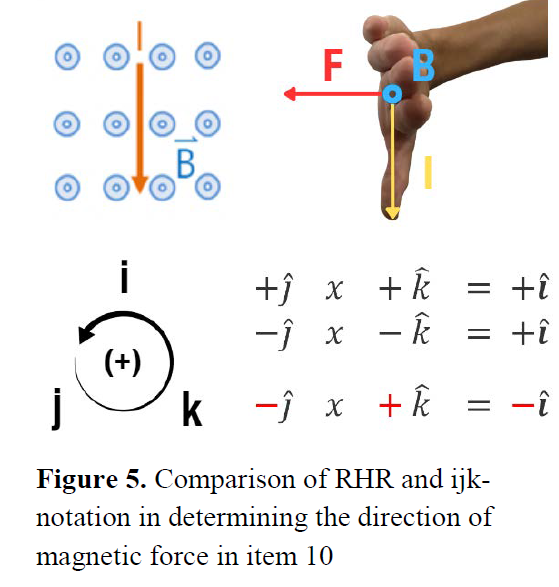Comparison of Fleming’s Right-hand Rule and ijk-notation in Determining the Direction of Magnetic Force
Main Article Content
Abstract
Fleming's Right-hand Rule (RHR) and ijk-notation are mnemonics that help students identify the direction of magnetic force. Literature has provided successes and limitations of each of these mnemonics, but no literature was found documenting the comparison of these mnemonics used in one Physics concept as these were normally used separately (i.e., RHR for electromagnetism and ijk notation for vectors in Math). This study employed a quasi-experimental one-group posttest-only design and the data were analyzed using Independent Samples t-test. This study underscores that Fleming's Right-hand Rule can better help students in identifying the direction of magnetic force than ijk-notation. The students emphasized that the use of ijk-notation is perplexing particularly when vectors differ in sign conventions, thus the low score using the said mnemonic.
Article Details

This work is licensed under a Creative Commons Attribution-NonCommercial-NoDerivatives 4.0 International License.
References
Buncher, J. B., and Ph, D. (n.d.). Algebra-Based Physics Students and Vectors: Can ijk Coaching Help Arrow Subtraction?, 2. Retrieved from https://www.per-central.org/perc/2018/posters/PERCPoster2018.pdf
Deprez, T., Gijsen, S. E., and Deprez, J. (2019). Investigating student understanding of cross products in a mathematical and two electromagnetism contexts. Physical Review Physics Education Research, 15(2), 20132. https://doi.org/10.1103/PhysRevPhysEducRes.15.020132
Van Domelen, D. J. (1999). Artificial right-hand rule device. Physics Teacher, 37(8), 500-501.
Heckler, A. F., and Scaife, T. M. (2015). Adding and subtracting vectors: The problem with the arrow representation. Physical Review Special Topics-Physics Education Research, 11(1), 010101. https://doi.org/10.1103/PhysRevSTPER.11.010101
Suryani, A. A., Iswanto, B. H., and Indrasari, W. (2021). Visualization Lorentz Force with Tea Leaves for Studying Magnetic Field in Senior High School. In Journal of Physics: Conference Series, 2019(1), 012023. https://doi.org/10.1088/1742-6596/2019/1/012023
Kustusch, M. B. (2016). Assessing the impact of representational and contextual problem features on student use of right-hand rules. Physical Review Physics Education Research, 12(1), 010102. https://doi.org/10.1103/PhysRevPhysEducRes.12.010102
Nguyen, N. L., and Meltzer, D. E. (2005). Visualization tool for 3-D relationships and the right-hand rule. Physics Teacher, 43(3), 155-157.
Onorato, P., and Ambrosis, A. De. (2014). Laboratory and Multimedia In Science Teaching: Experiments About Magnetic Force. Procedia - Social and Behavioral Sciences, 116, 1280–1287. https://doi.org/10.1016/j.sbspro.2014.01.383
Fatmaryanti, S. D., and Nugraha, D. A. (2019). Using multiple representations model to enhance student’s understanding in magnetic field direction concepts. Journal of Physics: Conference Series, 1153(1), 012147). https://doi.org/10.1088/1742-6596/1153/1/012147
Scaife, T. M., and Heckler, A. F. (2010). Student understanding of the direction of the magnetic force on a charged particle. American Journal of Physics, 78(8), 869-876.
Trivedi, R., and Sharma, M. P. (2013). A study of students’ attitude towards physics practical at senior secondary level. International Journal of Scientific and Research Publications, 3(8), 1-4.


